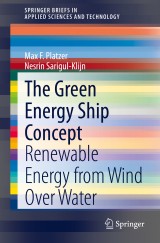Details

The Green Energy Ship Concept
Renewable Energy from Wind Over WaterSpringerBriefs in Applied Sciences and Technology
|
69,54 € |
|
| Verlag: | Springer |
| Format: | |
| Veröffentl.: | 05.12.2020 |
| ISBN/EAN: | 9783030582449 |
| Sprache: | englisch |
Dieses eBook enthält ein Wasserzeichen.
Beschreibungen
This groundbreaking book aims to show that technology currently exists to build and operate large autonomous sailing ships equipped with hydrokinetic turbines and electrolysers that could operate in high-wind ocean areas. This technology would enable seawater to be converted into storable hydrogen, thereby tapping into an inexhaustible energy reservoir sufficient for the transition to an emission-free global economy. The book is presented in two parts. Part one presents a broad look at possible solutions to the climate change challenge and provides an overview of current approaches. Part two introduces 12 specific technologies that could enable the green energy ship concept.
<div><p><b>Part I: General Considerations.- </b>1. Introduction.- 2. Current Status of Global Energy Consumption, Production and Storage.- 3. Climate Tipping Points and Climate Irreversibility.- 4. Review of Past Energy Transitions.- 5. Lessons from Past Major Engineering Initiatives.- 6 Recent Analyses and Current Proposals for Sustainable Global Power Production.- 7. Problem Definition.- 8. The Energy-Ship/ Wind-over-Water Concept.- 9. Major Elements and Developmental Status of the Energy Ship Concept.- 10. Comparison of the Wind-over-Water with the Wind-Water-Solar Concept.- 11. Sustainable Aviation.- 12. Proposal for a Global Renewable Energy Production and Storage Initiative.- 13. Summary and Outlook.- <b>Part II: Technical Aspects.- </b>14. Energy and Power Fundamentals.- 15. Hydrogen Characteristics.- 16. Hydrogen Production Methods4 Seawater Desalination.- 17. Sea Water Desalination.- 18. Energy Storage Systems.- 19. Hydrogen Compression Technology.- 20. Power from Air and Water Flows.- 21. Hydrokinetic Turbine Technology.- 22. Wind-propelled Ship Technology.- 23. Power from Wind over Water.- 24. Conversion of Hydrogen to Electricity.- 25. Production of Jet Fuel from Seawater.</p></div>
<p><b>Dr. Max F. Platzer</b> is an Adjunct Professor of Mechanical & Aerospace Engineering at the University of California Davis. He holds Diploma Engineer and Doctor of Technical Sciences degrees from the Technical University of Vienna, Austria. He was a member of Wernher von Braun's SATURN rocket development team for six years, chief of the Aeromechanics Research Section at the Lockheed-Georgia Research Center for four years and a Professor of Aeronautics and Astronautics at the Naval Postgraduate School, Monterey, California, for thirty-four years. Dr. Platzer received the distinguished professor medal of the Naval Postgraduate School. He is a Fellow of the American Institute of Aeronautics and Astronautics and of the American Society of Mechanical Engineers. Currently, he is editor of the international review journal "Progress in Aerospace Sciences".</p>
<div><b>Dr. Nesrin Sarigul-Klijn</b> is a Full Professor of Mechanical & Aerospace Engineering and the Founding Director of theSpace Engineering Research and Graduate Program at the University of California Davis. She received her Ph.D. degree from the University of Arizona. In addition to her engineering academic degrees, she is an instrument rated commercial pilot and an active participant of FAA wings. Her publications record of over 200 refereed technical works also include 5 patents and 2 books. She serves on the Editorial Board of the Journal of Progress in Aerospace Sciences. She is an associate fellow of the American Institute of Aeronautics and Astronautics, and fellow of American Society of Mechanical Engineers. Her cross-disciplinary research expertise are in fluid-structure interactions, acoustics and noise control, vibrations, dynamic separation of air launched vehicles, and autonomous systems.<br></div>
<div><b>Dr. Nesrin Sarigul-Klijn</b> is a Full Professor of Mechanical & Aerospace Engineering and the Founding Director of theSpace Engineering Research and Graduate Program at the University of California Davis. She received her Ph.D. degree from the University of Arizona. In addition to her engineering academic degrees, she is an instrument rated commercial pilot and an active participant of FAA wings. Her publications record of over 200 refereed technical works also include 5 patents and 2 books. She serves on the Editorial Board of the Journal of Progress in Aerospace Sciences. She is an associate fellow of the American Institute of Aeronautics and Astronautics, and fellow of American Society of Mechanical Engineers. Her cross-disciplinary research expertise are in fluid-structure interactions, acoustics and noise control, vibrations, dynamic separation of air launched vehicles, and autonomous systems.<br></div>
This groundbreaking book aims to show that technology currently exists to build and operate large autonomous sailing ships equipped with hydrokinetic turbines and electrolysers that could operate in high-wind ocean areas. This technology would enable seawater to be converted into storable hydrogen, thereby tapping into an inexhaustible energy reservoir sufficient for the transition to an emission-free global economy. The book is presented in two parts. Part one presents a broad look at possible solutions to the climate change challenge and provides an overview of current approaches. Part two introduces 12 specific technologies that could enable the green energy ship concept.<div><ul><li>Examines current approaches and solutions to the climate change challenge;</li><li>Looks at autonomous sailing ships operating in high-wind ocean areas;</li><li>Discusses technologies for converting seawater into storable hydrogen.</li></ul></div>
Examines current approaches and solutions to the climate change challenge Looks at autonomous sailing ships operating in high-wind ocean areas Discusses technologies for converting seawater into storable hydrogen

















